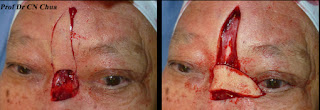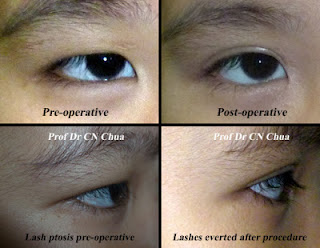Fat in the upper eyelid contributes to fullness of the lids. During double eyelid surgery, some of these fat are usually removed to allow better adhesion between the skin and the underlying tissue. However, if too much of this fat were removed, the upper eyelid may appear hollow and worse still some patients may develop multiple skin creases above the double eyelid. Therefore, experienced surgeon knows the importance of not aggressively removing the fat.
Sunken and hollow upper eyelid caused by excessive fat excision.
Also note the extra lines above the double eyelids.
Diagrams showing what happens when too much fat is removed.
a. Normal contour of double eyelid after procedure
b. Too much fat removed (red arrow) causing depression (hollow) upper eyelid
c. To overcome this problem the fat compartment needs to be pumped up (blue areas)
with either fat or substitutes such as hyaluronic acid.
The way to treat an eye that have too much fat removed is to replace the volume. This can either be fat transfer from other part of the body or using substitue such as fillers. The best filler with good safety record is hyaluronic acid.
Picture showing left sunken socket and extra lines due to fat depletion.
Hyaluronic acid was injected into the depressed area (arrows)
to pump up the sunken area and removed the extra lines.
(the last picture was taken immediately after injection)
Another patient with too much fat removal causing left sunken lid.
The lower picture was taken a few days after hyaluronic acid injection.































